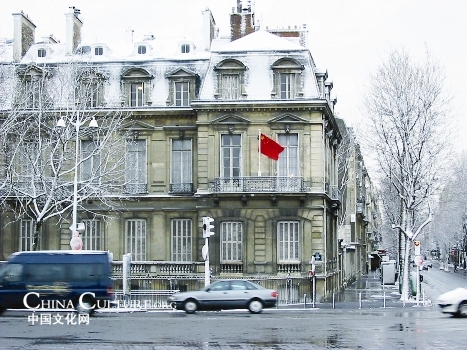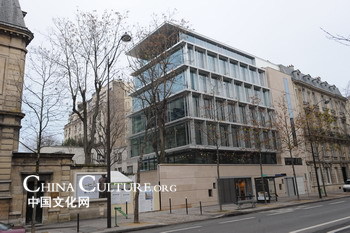| In Paris
French people largely put traditions and cultural atmosphere at a premium. In Paris, people are particular about sectors of an area when they come to taking up their abode. The Chinese Cultural Center in Paris, located in downtown areas opposing the celebrated historic sites of Grand Palais and Petit Palais across the Seine River, sits next to a spate of stately, handsome and elegant classical architectures that have witnessed the evolution of Paris at various historical stages. It conforms to the status of China, a great power with a lasting civilization of several thousand years in the East, to set the Chinese Cultural Center in this exact place.
The old building of the Chinese Cultural Center in Paris The center has been open to the public for more than a month since it officially went into operation. It has attracted high attention from all circles of life in France, particularly local residents who are fond of the Chinese culture. It is the first time for China to set up a cultural center in western developed countries. France, a major cultural power, was the first among western countries to set up diplomat relations with the People’s Republic of China. On this account, China selected Paris to host its cultural center to meet the requirements of continuously expanded cultural exchanges between the two countries. The center will serve as a platform to enhance friendly dialogue between the ancient yet thriving Chinese civilization and the romantic French civilization. It will also furnish French people a channel to better understand China in a wider scope.
The new building of the Chinese Cultural Center in Paris The amazing progress in smoothly selecting the site for the Chinese Cultural Center and putting it into operation in downtown Paris in such a short period was attributed to high priority of the Chinese government, constructive cooperation of the French party, and arduous yet effective performances of the task force of the center. Wu Jianmin, Chinese ambassador to France, said with emotion, “We have our own cultural center in Paris at last, and we have eventually realized the long-cherished wish of my predecessors in the Chinese embassy.” Hou Xianghua, the first director of the Chinese Cultural Center in Paris, said the center will stick up with its “non-governmental” nature and greet people from all walks of life, in addition to serving the mainstream society. 19th CENTURY COUNT RESIDENCE French people largely put traditions and cultural atmosphere at a premium. In Paris, people are particular about sectors of an area when they come to taking up their abode. The Chinese Cultural Center in Paris, located in downtown areas opposing the celebrated historic sites of Grand Palais and Petit Palais across the Seine River, sits next to a spate of stately, handsome and elegant classical architectures that have witnessed the evolution of Paris at various historical stages. It conforms to the status of China, a great power with a lasting civilization of several thousand years in the East, to set the Chinese Cultural Center in this exact place. The Chinese Cultural Center went into official operation on November 29, 2002, marked with a red-carpet ceremony. “It is worthwhile to come a long way here, just think about the specific site,” said Zhao Wuji and Zhu Dequn, renowned painters of Chinese origin, on-scene. Located at the cross point where BOULEVARD DELATOUR-MAUBOURG meets QUAID’ORSAY in the seventh arrondissement of Paris, the center is a close neighbor of the famous Les Invalides Square to the west, adjoining the Seine River. The office building of the center, constructed of stones nearly 150 years ago, has imposing windows extending to the roof. It was a private residence of the French Count Montesquieu Fusansack of the 19th century. The stone structure on its right side was actually a sister building, currently owned by the France Association of Mayors. They were designed and constructed under the orders of the Countess in 1858 for her two sons. Step into the building, and you will instantly revel in the flavor of the stairs. The marble stairs, placed at the west side of the building, remain to look brand-new, despite the passage of time. Ascend the luxury and fancy stairs step by step upon scarlet carpets. You will see pendant lamps hung from ornamented roofs. Two nude women sculptures stand loftily at the upper parts of the pillars on each side. The walls, also decorated with marbles of simple and elegant natural patterns, look just like inartificial artworks as they are circled with frames. Experts say that wall decorations are made of imitated marbles, which are more expensive than natural marbles. It is thus evident the original house owner was of very high artistic taste. The building has four floors, with the first and second floors most often used. Light and spacious rooms are joined in the building. Though short of decorations, the walls remain rarefied in style. The wooden decorations are fine in workmanship, actually “works of consummate skills”. The lacquers upon some doors look coarse, as they are dark and lackluster. However, they are of best quality. They have been enrolled in the cultural heritage protection list, just as the overall building is, because the technique to mix such lacquers might have been lost. PROMPT DECISION FOR PROCUREMENT China and France have talked it over for a long time to set up a cultural center in each other’s land. They eventually signed an agreement in 2001. On April 19, 2001, Chinese vice-premier Li Lanqing and French foreign minister Hubert Védrine subscribed a minutes of talks in Paris, deciding to settle the cultural centers in the capital cities. It subsequently became an urgent affair to select sites for the forthcoming cultural centers. The Chinese government did everything and finally singled out the present building. Although it was built about 150 years ago, the building remains to have good conditions. It is a classical architecture under the French government’s list for cultural heritage protection. Besides, it sits in an ideal section of land, with the Seine River flowing in the front. As a part of the “most splendid areas” in Paris in all ages, the building shows off history and modernity. It accords with the weight of China, an oriental civilization, to set up the cultural center in the building. The next thing was to bargain with the landlord to fix upon sales price. The building was sold for some times over the past century. The current owner was a descendent of old-time aristocrats. Two families, aunt and nephew, lived in the building. On the reasons of economy, they decided to sell the building and move to other places. The building was finally sold at a price accepted by both parties. The Chinese Cultural Center became the new owner of the building. On December 29 last year, Chinese Cultural Center in Paris went into official operation with a grand inauguration ceremony. Senior Chinese and French officials and celebrities from the cultural and artistic circles put in an appearance. Chinese vice-premier Li Lanqing revisited Paris to unveil the center sign. At the same day, the Chinese and French governments officially signed an agreement to set up cultural centers in each other’s capital and confirm their roles, turning over a new page in the history of cultural exchanges and cooperation between the two countries. MULTI-FUNCTIONAL CULTURAL CENTER Chinese Cultural Center in Paris has a building area of 1,700 square meters. It plans to renovate the old building in the near future and have a new building constructed in the courtyard. When the project is completed, the center will have a building area of 4,000 square meters and serve as a multi-functional place for cultural activities with rich Chinese characteristics. It will host such facilities as small theatre, lecture hall, classroom and reading room. The center has mapped out plans for seminars, forums, performances, concerts and exhibitions. It will sponsor and participate in cultural and technological exhibitions to popularize China’s progress in these fields. Other projects comprise: recommend and show movies and video programs; print and distribute program prospectus, painting albums, and cultural, teaching and scientific documents in other mediums; open up library, reading room, and data room; invite Chinese artists, researchers, and seminar lecturers; and open up Chinese language courses and other training courses. Schedule of activities in the third quarter of 2010 Schedule of activities in the second quarter of 2010 Schedule of activities in the first quarter of 2010 Schedule of activities in the third quarter of 2009 |
||

